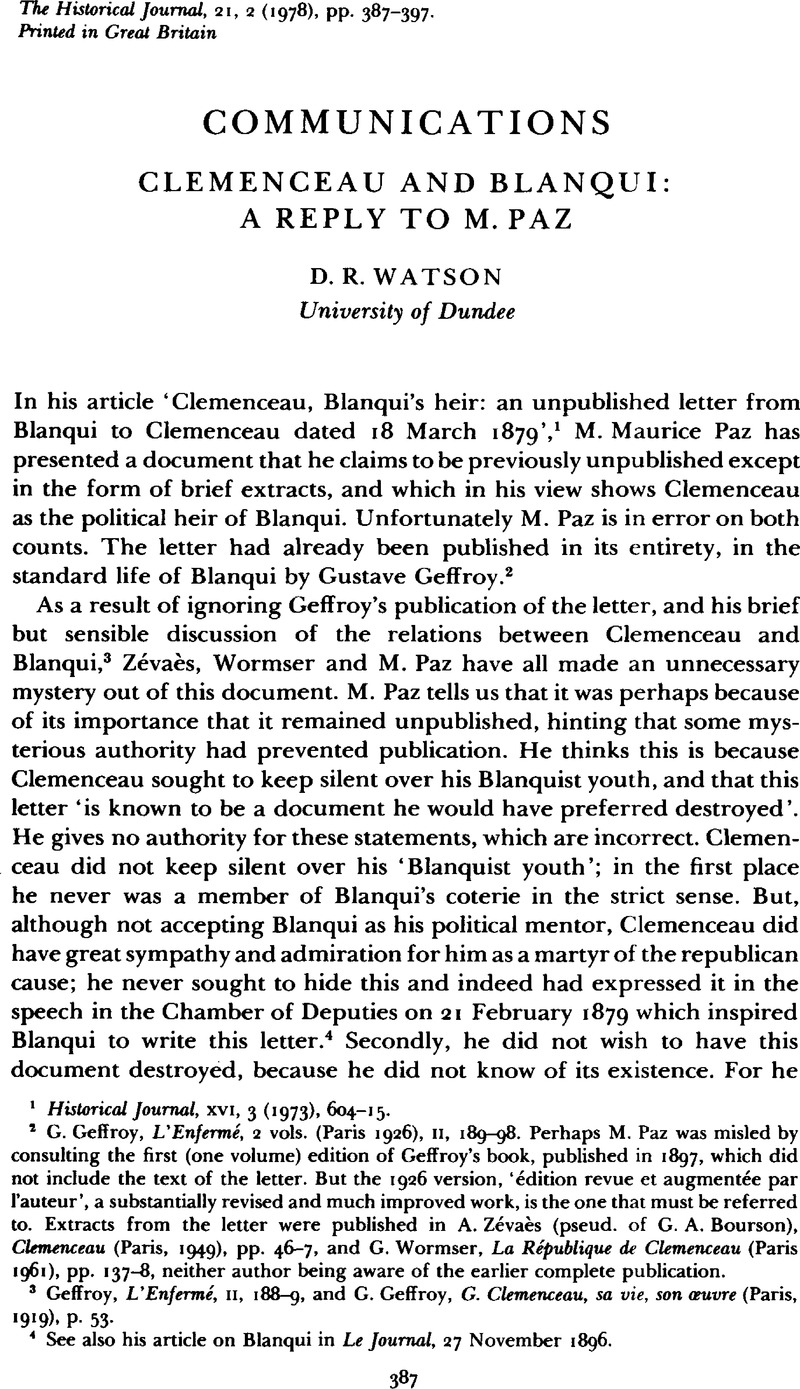No CrossRef data available.
Article contents
Clemenceau and Blanqui: a Reply to M. Paz
Published online by Cambridge University Press: 11 February 2009
Abstract

- Type
- Communications
- Information
- Copyright
- Copyright © Cambridge University Press 1978
References
1 Historical Journal, XVI, 3 (1973), 604–15.Google Scholar
2 Geffroy, G., L'Enfermé, 2 vols. (Paris 1926), II, 189–98Google Scholar. Perhaps M. Paz was misled by consulting the first (one volume) edition of Geffrey's book, published in 1897, which did not include the text of the letter. But the 1926 version, ‘édition revue et augmentée par l'auteur’, a substantially revised and much improved work, is the one that must be referred to. Extracts from the letter were published in Zévaès, A. (pseud, of G. A. Bourson), Clemenceau (Paris, 1949), pp. 46–7Google Scholar, and Wormser, G., La République de Clemenceau (Paris 1961), pp. 137–8Google Scholar, neither author being aware of the earlier complete publication.
3 Geffroy, , L'Enfermé, II, 188–9Google Scholar, and Geffroy, G., G. Clemenceau, sa vie, son œuvre (Paris, 1919). P. 53.Google Scholar
4 See also his article on Blanqui, in Le Journal, 27 11 1896.Google Scholar
5 Geffroy, , L'Enfermé, II, 188.Google Scholar
6 M. Wormser controls the small collection of Clemenceau's papers at the Musée Clemenceau, and generally refuses students permission to consult the unpublished material, although he places at their disposal the complete collection of Clemenceau's published books and newspaper articles preserved there. I know of the existence of this letter, but not its contents, as I was allowed to see the inventory of the unpublished documents at the Musée Clemenceau.
7 Holt, E., The Tiger, the life of Georges Clemenceau 1841–1929 (London, 1976), p. 40Google Scholar. Mr Holt quotes several passages from M. Paz's article, thinking that it provides new information not known to earlier biographers, and quotes some of M. Paz's most misleading comments on its significance.
8 Watson, D. R., Georges Clemenceau, a political biography (London, 1974), pp. 17–18Google Scholar, and Martet, J., Clemenceau peint par lui-même (Paris, 1929), p. 161.Google Scholar
9 Martet, , Clemenceau, pp. 257–69Google Scholar, prints extracts from Clemenceau's composition. They arediscussed in Watson, D. R., ‘Clemenceau and Mill’, The Mill News Letter, VI, i (1970), 13–19.Google Scholar
10 For these events see Watson, , Clemenceau, p. 24Google Scholar; Tchernoff, I., Le parti républicain au coup d'état et sous le Second Empire (Paris, 1906), pp. 143, 338Google Scholar; Scheurer-Kestner, A., Souvenirs de jeunesse (Paris, 1905), pp. 75–87Google Scholar; Dommanget, M., Blanqui et l'opposition révolutionnaire à la fin du Second Empire (Paris, 1960), p. 53.Google Scholar
11 See the amusing description of a meeting of Blanqui's club during the siege of Paris in 1870 – ‘C'était comme une chapelle consacrée au culte orthodoxe de la conspiration classique, où les portes étaient ouvertes à tout la monde, mais où l'on ne sentait l'envie de revenir que si l'on était un accepté’ – by Weiss, J. J., Le Journal, 18 02 1872Google Scholar, quoted by Zévaès, A., Auguste Blanqui (Paris, 1920), pp. 182–7.Google Scholar
12 Scheurer-Kestner, , Souvenirs, pp. 98–9Google Scholar, and in more detail in the MSS version, Bibliothèque Nationale, NAF 12704, fos. 213–14.
13 Dommanget, , Blanqui, p. 53.Google Scholar
14 Watson, , Clemenceau, p. 37.Google Scholar
15 Ibid. p. 41–3.
16 Historical Journal, XVI, 3 (1973), 606.Google Scholar
17 Journal Officiel de la République Française, 22 Fév. 1879, p. 1313Google Scholar, and Annales de la Chambre dés Députés, 1879, II, 183Google Scholar. Clemenceau's speech is given in exactly the same words in both reports, the Journal Officiel proper, distributed the next day from the stenographer's version, and in the annual recapitulatory volume. There are sometimes differences between the two versions, as deputies were allowed to offer their own corrections to the version originally published, but that is not the case here. M. Paz has simply mistranscribed or mistranslated a word which is absolutely crucial to his argument.
18 da Costa, G., Les Blanquistes (Paris 1912, vol. 6 of Histoire des partis socialistes en France, ed. Zévaès, A.), pp. 57–69.Google Scholar
19 Watson, , Clemenceau, p. 66–7.Google Scholar
20 Joughin, J. T., ‘The Paris Commune in French politics 1871–1880, the history of the amnesty of 1880 (Baltimore, 1955), p. 496.Google Scholar
21 Zévaès, , Blanqui, p. 104.Google Scholar
22 Ibid. p. 106; on the petitions from Marseille, Toulouse, Nice and Paris for Blanqui's release, Geffroy, G., L'Enfermé, II, 188.Google Scholar
23 Hanotaux, G., Contemporary France (London 1909), IV, 454–6, 460Google Scholar; Zévaès, , Blanqui, pp. 107–8.Google Scholar
24 Zévaès, , Blanqui, pp. 112–13.Google Scholar
25 Annales de la Chambre des Députés, 3 06 1879, p. 68.Google Scholar
26 Watson, , Clemenceau, pp. 85–6Google Scholar, and references there cited, especially the letter from Marx to Sorge, 5 November 1880, Marx-Engels, , Werke (Berlin, 1966), XXXIV, 476–7.Google Scholar
27 Watson, , Clemenceau, p. 71Google Scholar. I hope to explore this theme more fully in a subsequent article.
28 Zévaès, A., Blanqui, p. 117Google Scholar. Thomas, E., Louise Michel ou la Velléda de l'anarchie (Paris, 1971), p. 197Google Scholar. Clemenceau was not able to attend because of a previous engagement; he sent a wreath, and defended himself in the columns of La Justice against the charge of having voluntarily absented himself.




